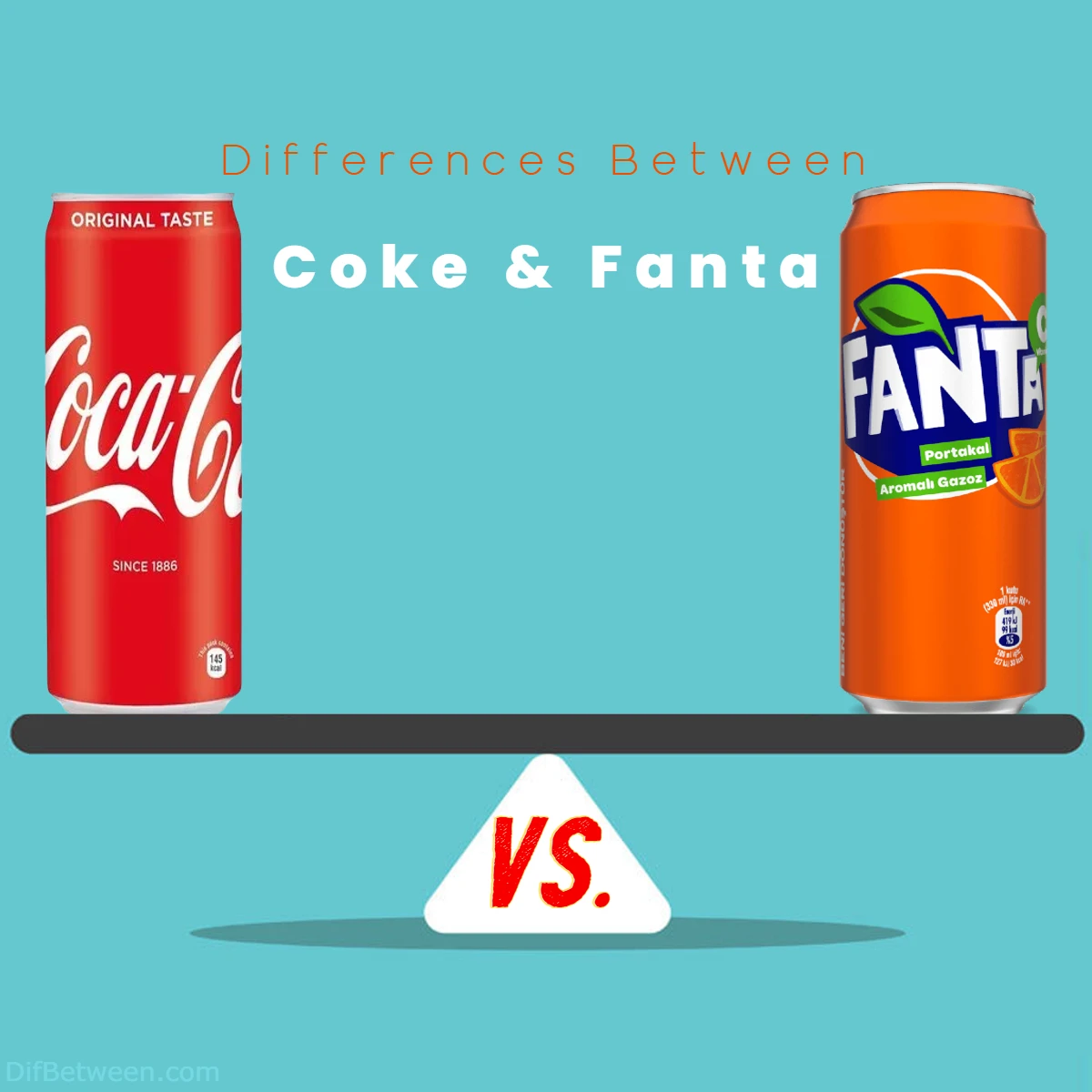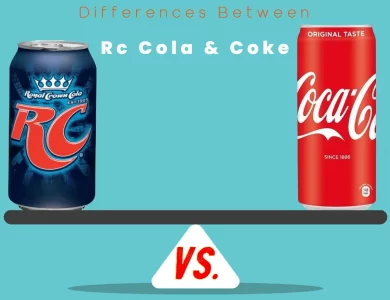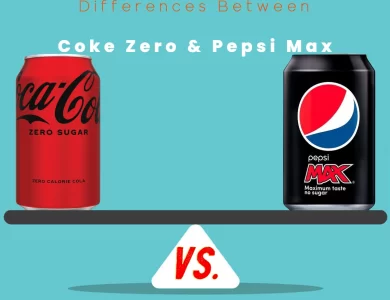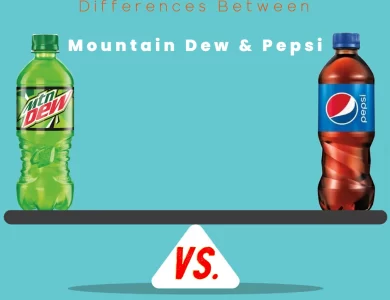
| Aspect | Coca-Cola (Coke) | Fanta |
|---|---|---|
| Origin | Invented by John S. Pemberton in 1886. | Created in Nazi Germany during World War II (1940). |
| Flavor Profile | Classic cola taste with sweetness and acidity. | Vibrant and fruity flavors with diverse options. |
| Primary Ingredients | Carbonated water, high-fructose corn syrup, caramel color, phosphoric acid, natural flavors, caffeine (varies). | Carbonated water, high-fructose corn syrup, natural flavors, citric acid, preservatives. Some variants may contain real fruit juice. |
| Caffeine Content | Contains caffeine (~34mg per 12 fl oz, varies with variants). | Caffeine-free (0mg per 12 fl oz). |
| Color and Appearance | Dark brown with caramel color. | Vibrant color based on the fruit flavor (e.g., orange, red, purple). |
| Carbonation Levels | Effervescent and fizzy. | Light and bubbly, complements fruit flavors. |
| Sweeteners | High-fructose corn syrup or other sweeteners (varies). | High-fructose corn syrup or other sweeteners (varies). |
| Serving Sizes | Available in various sizes, including cans and bottles. | Available in various sizes, including cans and bottles. |
| Caffeine-Free Options | No caffeine-free variant (except decaffeinated Coke). | Caffeine-free across all variants. |
| Global Reach | Widely distributed and available worldwide. | Presence in various countries, but not as widespread as Coke. |
| Marketing and Appeal | Known for emotional and universal messages of joy and unity. | Emphasizes fun, youthful, and adventurous branding. |
| Pairing with Food | Versatile, complements a wide range of dishes. | Fruit flavors pair well with specific cuisines and desserts. |
| Environmental Impact | Efforts to reduce carbon footprint and increase sustainability. | Part of broader environmental sustainability initiatives. |
| Regional Variations | Limited regional variations. | Diverse regional flavors catering to local preferences. |
| Market Competition | Faces competition in the cola and soft drink market. | Competes with other fruit-flavored sodas and soft drinks. |
If you’ve ever found yourself pondering the delightful dilemma of choosing between two classic beverages – Coca-Cola and Fanta – then you’ve come to the right place! In this fizzy adventure, we’ll dive into the enchanting world of Coke and Fanta, exploring their vibrant flavors, intriguing histories, and everything that sets them apart. From the timeless cola taste of Coca-Cola to the playful burst of fruity goodness in Fanta, each sip is an invitation to experience a world of refreshment. So, buckle up and join me as we uncover the secrets and stories behind these beloved sodas!
Differences Between Coke and Fanta
The main difference between Coke and Fanta lies in their flavor profiles. Coca-Cola, popularly known as Coke, offers a classic cola taste with a well-balanced blend of sweetness and acidity, creating a refreshing and iconic beverage. On the other hand, Fanta stands out with its vibrant and fruity flavors, ranging from orange and grape to strawberry, providing a diverse selection of taste experiences. While Coke boasts a timeless cola appeal, Fanta appeals to consumers seeking a variety of fruit-inspired soda choices, making both beverages unique in their own right.
History and Origins
Coca-Cola (Coke): Let’s kick things off with the beverage that needs no introduction – Coca-Cola, affectionately known as Coke. This legendary soft drink has a rich history dating back to the late 19th century. Invented by John S. Pemberton in 1886, the original Coke was intended as a medicinal tonic, containing a combination of coca leaves (source of cocaine) and kola nuts. However, the cocaine was later removed, and the formula evolved into the iconic beverage we know today.
Fanta: On the other hand, we have Fanta, a vibrant and fruity creation of The Coca-Cola Company as well. Fanta’s origin story, interestingly, dates back to World War II, precisely in Nazi Germany. Due to ingredient shortages during the war, a local bottling plant under Coca-Cola’s control created a new soda using whatever was available – fruit flavors and leftover materials from other beverage productions. This resulted in the birth of Fanta in 1940, and it has been delighting taste buds ever since.
Flavor Profiles
Coke: Coca-Cola boasts a classic and timeless flavor profile that’s hard to beat. Its primary taste is a delightful combination of sweetness and a hint of acidity, with a unique blend of secret ingredients (known as “Merchandise 7X”) that remains closely guarded by the company. The dominant flavor notes are caramel, vanilla, and a zesty kick, giving Coke its signature taste loved by millions worldwide.
Fanta: Fanta, true to its innovative roots, offers a completely different flavor experience. It is known for its bold, fruit-infused taste that varies depending on the region. With a wide array of fruity options available, Fanta has something for everyone. From the zesty orange to the tropical pineapple, and from the sweet strawberry to the tangy grape – Fanta bursts with vibrant flavors that cater to diverse palates.

To compare their nutritional content, let’s take a look at this table:
| Nutritional Content (per 12 fl oz) | Coca-Cola (Coke) | Fanta Orange |
|---|---|---|
| Calories | 140 | 160 |
| Total Fat | 0g | 0g |
| Sodium | 45mg | 45mg |
| Total Carbohydrates | 39g | 44g |
| Sugars | 39g | 44g |
| Protein | 0g | 0g |
Note: Nutritional values may vary based on regional regulations and product variants.
Carbonation Levels
Coke: One of the defining characteristics of Coca-Cola is its fizzy and effervescent nature. The carbonation levels in Coke are carefully calibrated to create the perfect balance of bubbles, enhancing the overall drinking experience. The carbon dioxide gas dissolved in the beverage gives it that signature “tingly” sensation on the tongue, making each sip feel refreshing.
Fanta: Fanta’s carbonation levels, too, play a significant role in defining its unique identity. As a fruit-flavored soda, Fanta strikes a delicate balance between fizziness and the fruitiness of its flavors. The carbonation enhances the fruit essence, making it an enjoyable beverage for those who prefer a lighter and less intense fizz.
Caffeine Content
Coke: One characteristic that sets Coke apart from Fanta is its caffeine content. Coca-Cola contains caffeine, although the amount can vary depending on the specific variant and region. The caffeine in Coke can provide a mild stimulant effect, making it a popular choice for people looking for a gentle pick-me-up during their day.
Fanta: In contrast, Fanta is a caffeine-free beverage, which is one of its appealing attributes. This makes Fanta a preferred option for those who wish to avoid caffeine or are sensitive to its effects, including children and individuals who prefer a caffeine-free lifestyle.
To compare their caffeine content, here’s a quick reference:
| Caffeine Content (per 12 fl oz) | Coca-Cola (Coke) | Fanta Orange |
|---|---|---|
| Caffeine | ~34mg | 0mg |
Note: Caffeine content may vary based on regional regulations and product variants.

Color and Appearance
Coke: Coca-Cola exhibits a dark brown, almost cola-like hue, which is partly due to the caramel coloring used in its formulation. This distinctive color is easily recognizable and sets it apart from other clear or lightly colored soft drinks.
Fanta: In contrast, Fanta prides itself on its vibrantly colored appearance. Each Fanta variant showcases its characteristic color, such as the bright orange for Fanta Orange, the luscious red for Fanta Strawberry, or the grape-purple for Fanta Grape. This visual appeal adds to the overall experience of indulging in a Fanta soda.
Brand Variants and Global Reach
Coke: Coca-Cola is a global behemoth with a vast array of product variants. Apart from the classic Coca-Cola, the company offers various other options like Diet Coke, Coca-Cola Zero Sugar, Cherry Coke, Vanilla Coke, and many more. With an unrivaled global reach, you can find Coca-Cola products in almost every corner of the world.
Fanta: While Fanta might not be as widespread as Coca-Cola, it has earned its own loyal fan base, and its popularity continues to grow steadily. Fanta’s global presence is notable, with diverse fruit flavors catering to different regions and cultural preferences.
Serving Sizes and Packaging
Coke: Coca-Cola is available in a variety of sizes, ranging from standard 12-ounce cans and 20-ounce bottles to larger 2-liter containers. Its omnipresence means you can find it in various restaurants, movie theaters, vending machines, and grocery stores.
Fanta: Fanta is also offered in various sizes, following a similar format to Coca-Cola. Its packaging is designed to be eye-catching and youthful, reflecting the vibrant and fun nature of the beverage itself.
Marketing and Appeal
Coke: Coca-Cola’s marketing campaigns have become legendary over the years, known for their emotional appeal and universal messages of happiness, unity, and joy. The iconic “Share a Coke” campaign, where bottles were personalized with popular names, is a testament to Coke’s marketing creativity and engagement with its consumers.
Fanta: Fanta’s marketing, on the other hand, often focuses on its fruit-forward and playful characteristics. The brand’s advertisements are targeted at a younger demographic, emphasizing the refreshing and adventurous aspects of the beverage.
Sweeteners and Formulations
Coke: Traditionally, Coca-Cola is sweetened with high-fructose corn syrup (HFCS) in the United States. However, formulations may vary in other regions, with some countries using sucrose or cane sugar instead. Additionally, diet versions use artificial sweeteners like aspartame or sucralose to provide the classic taste with fewer calories.
Fanta: Fanta, like Coke, also utilizes various sweeteners based on regional preferences. Some Fanta variations contain HFCS, while others use alternative sweeteners to cater to specific markets and dietary requirements.
Cultural Relevance and Popularity
Coke: Coca-Cola’s cultural significance is unparalleled. It has been featured in numerous movies, songs, and advertisements, solidifying its status as a global icon. Its red and white logo is instantly recognizable, making it a symbol of enjoyment and togetherness across cultures.
Fanta: While Fanta might not have reached the same level of cultural ubiquity as Coca-Cola, it remains a beloved choice, especially among younger demographics. Its fun flavors and colorful branding have helped it carve a unique identity in the soft drink landscape.
Ingredients and Formulations
Coke: The secret formula of Coca-Cola, known as “Merchandise 7X,” remains one of the best-kept secrets in the beverage industry. While the exact ingredients are undisclosed, we do know that Coke primarily contains carbonated water, high-fructose corn syrup (or other sweeteners in different regions), caramel color, phosphoric acid, natural flavors (which contribute to its unique taste), and caffeine. Some variants, like Diet Coke and Coca-Cola Zero Sugar, use artificial sweeteners to provide a sugar-free option.
Fanta: Fanta’s ingredients vary depending on the flavor, but in general, it contains carbonated water, high-fructose corn syrup (or other sweeteners), natural flavors that give each variant its distinct taste, citric acid (to add tartness), and preservatives. One thing that sets Fanta apart is its utilization of real fruit juice in some formulations, adding to the authentic fruit flavors in certain variants.
Health Considerations
Coke: As with any sugary beverage, it’s essential to consume Coca-Cola in moderation. The high sugar content in Coke contributes to its delicious taste but also means that excessive consumption can lead to increased calorie intake and potential health risks associated with consuming too much added sugar. Additionally, the caffeine content in Coke may affect some individuals, especially those sensitive to caffeine or those with certain health conditions.
Fanta: Similarly, Fanta should also be enjoyed in moderation due to its sugar content. However, some Fanta variants have lower sugar levels compared to Coca-Cola, making them a relatively better option for those who wish to reduce their sugar intake. Additionally, Fanta’s caffeine-free nature makes it a suitable choice for people looking to avoid caffeine altogether.
Pairing with Food
Coke: Coca-Cola’s classic taste complements a wide range of food choices, making it a popular accompaniment to meals. Its sweetness and acidity can balance savory dishes, while its carbonation can help cleanse the palate between bites. Coke is often associated with burgers, pizzas, barbecues, and other hearty comfort foods.
Fanta: Fanta’s fruity flavors lend themselves well to pairing with specific cuisines. For example, Fanta Orange complements spicy dishes, Fanta Pineapple enhances tropical and exotic flavors, and Fanta Grape can be an excellent match for desserts. The versatility of Fanta makes it a delightful choice to experiment with different food combinations.
Environmental Impact
Coke: Being a global beverage giant, Coca-Cola has taken steps to address its environmental impact. The company has set sustainability goals and initiatives to reduce its carbon footprint, increase recycling rates, and optimize water usage. Efforts have also been made to introduce more eco-friendly packaging and explore alternative sourcing for ingredients.
Fanta: As a product of The Coca-Cola Company, Fanta is also part of the company’s environmental sustainability efforts. The focus on recycling and sustainable sourcing applies to Fanta’s packaging and ingredients as well, aligning with the broader corporate mission.
Regional Variations
Coke: One exciting aspect of Coca-Cola is its regional variations around the world. Different countries often offer exclusive Coca-Cola flavors that cater to local tastes and preferences. For example, you may come across regional variants like Coca-Cola with lime, cherry, or unique fruit blends, adding to the intrigue and excitement for adventurous soda enthusiasts.
Fanta: Fanta takes this concept of regional variations a step further. Each Fanta variant is often tailored to appeal to specific cultural and flavor preferences in different countries. As a result, Fanta’s range of flavors is incredibly diverse, allowing consumers to explore the tastes of various fruits from around the globe.
Market Competition and Innovation
Coke: Coca-Cola faces stiff competition in the carbonated beverage market. Besides battling with other cola brands, it also competes with a wide range of soft drinks, energy drinks, and other non-alcoholic beverages. In response to changing consumer preferences and health concerns, Coca-Cola continues to innovate by introducing new low-calorie or sugar-free options and exploring alternative beverage categories.
Fanta: While not as dominant as Coca-Cola in the global market, Fanta competes fiercely with other fruit-flavored sodas and soft drinks. To stay relevant and appeal to its target audience, Fanta regularly introduces limited-edition flavors, engages in creative marketing campaigns, and adapts its formulations to suit evolving consumer demands.
Coke or Fanta: Which One Should You Choose?
In this extended comparison between Coke and Fanta, we’ve delved deeper into their ingredients, health considerations, regional variations, and market competition. Both Coca-Cola and Fanta have solidified their places in the soft drink industry, each with its unique characteristics and appeal.
Choose Coke If:
- Classic Cola Craving: If you’re in the mood for that familiar, classic cola taste with a perfect balance of sweetness and acidity, Coca-Cola is your go-to choice. Its timeless flavor is a hit with millions worldwide, and it pairs wonderfully with a variety of foods.
- Need a Caffeine Boost: If you’re looking for a mild pick-me-up, Coca-Cola contains caffeine (around 34mg per 12 fl oz), making it a suitable option for those who appreciate a subtle energy lift.
- Versatility with Food: Coca-Cola’s versatility makes it an excellent companion to a wide range of meals. Its caramel notes and fizzy nature can complement savory dishes and provide a refreshing contrast.
- Global Icon Status: If you want to experience the soda that has left an indelible mark on pop culture and enjoy its rich history and global recognition, then Coca-Cola is the way to go.
Choose Fanta If:
- Fruity Flavors: If you’re in the mood for fun and fruity flavors, Fanta is the winner here. With an array of vibrant options like Orange, Pineapple, Strawberry, and Grape, Fanta caters to diverse taste preferences.
- Caffeine-Free Option: If you prefer to steer clear of caffeine or are sensitive to its effects, Fanta offers a caffeine-free alternative, making it a family-friendly and refreshing choice for everyone.
- Exciting Pairings: Fanta’s fruity profiles make it an exciting companion to specific dishes and desserts. Depending on the flavor, it can enhance the taste of your meal and add a refreshing twist to your dining experience.
- Adventurous Spirit: If you enjoy trying out new and unique flavors or exploring regional variations, Fanta’s diverse range of fruity options is sure to satisfy your sense of adventure.
Remember, Moderation is Key:
Regardless of your choice, remember that both Coke and Fanta are sugary beverages, and excessive consumption should be avoided. Enjoy them as occasional treats while maintaining a balanced diet and lifestyle.
In the end, there’s no right or wrong answer when it comes to Coke or Fanta. It all depends on what tickles your taste buds and suits the occasion. So go ahead, indulge in a refreshing soda, and savor the delightful flavors of these beloved carbonated beverages! Cheers!
FAQs
The main difference lies in their flavor profiles. Coca-Cola offers a classic cola taste with a balanced mix of sweetness and acidity, while Fanta boasts a range of vibrant and fruity flavors, each showcasing its unique taste.
Yes, Coca-Cola contains caffeine, though the amount varies depending on the specific variant and region. On average, a 12 fl oz serving of Coke contains around 34mg of caffeine.
Yes, Fanta is caffeine-free across all variants. It makes for a suitable choice for those who prefer to avoid caffeine or have sensitivity to its effects.
The sugar content in both varies based on the specific variant and region. On average, they have a similar amount of sugar per serving, with Fanta sometimes having a slightly higher sugar content.
Yes, both Coke and Fanta can be enjoyed with a variety of dishes. Coca-Cola’s classic taste complements a wide range of foods, while Fanta’s fruity flavors can be paired with specific cuisines and desserts for a delightful experience.
While most Coca-Cola variants contain caffeine, there is a decaffeinated option available for those who prefer a caffeine-free choice.
Coca-Cola has a more extensive global presence and is available in almost every corner of the world. Fanta, while widespread, might not be as dominant in certain regions compared to Coca-Cola.
Yes, both Coke and Fanta offer regional variations, with some countries having exclusive flavors that cater to local tastes and preferences.
Both Coca-Cola and Fanta are part of their company’s environmental sustainability efforts. They have initiatives to reduce their carbon footprint, increase recycling rates, and explore eco-friendly packaging options.
Yes, both Coke and Fanta are available in various sizes, ranging from standard 12-ounce cans and 20-ounce bottles to larger 2-liter containers, catering to individual preferences and occasions.
Read More:
Contents
- Differences Between Coke and Fanta
- History and Origins
- Flavor Profiles
- Carbonation Levels
- Caffeine Content
- Color and Appearance
- Brand Variants and Global Reach
- Serving Sizes and Packaging
- Marketing and Appeal
- Sweeteners and Formulations
- Cultural Relevance and Popularity
- Ingredients and Formulations
- Health Considerations
- Pairing with Food
- Environmental Impact
- Regional Variations
- Market Competition and Innovation
- Coke or Fanta: Which One Should You Choose?
- FAQs





